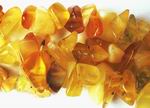
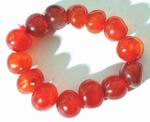
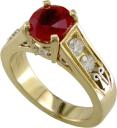

|
|
|
|
|
Ruby, Carnelian, Findings, & Chips
You have received this newsletter because you opted after a past purchase, but should you wish to be taken off the mailing list, just click the link at the bottom. This month we cover ruby, carnelian, findings, coloring, & chip beads. Scroll down, or click one of the links below on the html version to go to a certain section. If you have any suggestions for the future, please e-mail me at suggestions@mrbead.com.
If you
weren't mailed this newsletter enter your e-mail address
here to receive next month's
newsletter.
Summer Vacation - Some orders may be delayed between 14th July to 3rd August. If a problem please e-mail to check
Carnelian - alternate gemstone for July
About the author – Nigel Mckay
Chips go a long way!
10% off Offer
Ruby – July’s Birthstone



Like a perfect red rose, the Ruby's rich color speaks of love and passion. July's birthstone is among the most highly prized of gems throughout history. The Ruby was considered to have magical powers, and was worn by royalty as a talisman against evil. It was thought to grow darker when danger was imminent, and to return to its original color once safe.
The word Ruby comes from the Latin "ruber," meaning red. Ruby is the hardest mineral after diamond, a variety of the mineral Corundum, and is found as crystals within metamorphic rock. It comes in a variety of colors, and is called a sapphire in any color except red. Rubies range in hue from an orangey red to a purplish red, but the most prized gems are a true red. Large rubies are very rare and valuable. The most beautiful crystals are thought to be from Burma, but they are also found in many other countries.
Rubies were thought to represent heat and power. Ancient tribes used the gem as bullets for blowguns, and it was said that a ruby would boil water instantly. Ground to powder, this crystal was used as a cure for indigestion - and it has been said that the ruby's red glow comes from an internal flame that cannot be extinguished, making a gift of this stone symbolic of everlasting love. And if worn on the left hand, ancient lore has it that the ruby will bring good fortune to its wearer. to top
Carnelian – alternate gemstone for
July

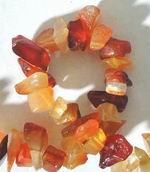
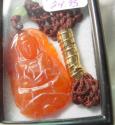
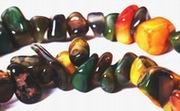
This flesh-colored stone comes from the quartz family, and is usually bright orange to reddish orange, translucent to clear. Carnelian has brought many ancient beliefs, like protection during travel after death and against evil. It is also believed to combat bad tempers. The name comes from the Latin word "Carnis" meaning flesh. The Roman thought that the darker Carnelian represented males and the lighter, females. Many believe that it creates a bond with man and nature.
Carnelian is for confidence. Said to help blood disorders and eliminate toxins from the body. Carnelian is in tune with the energies of the Earth, making you feel comfortable with your environment. Allowing you to pause and reflect, while feeling settled and more secure. Carnelian stimulates the reproductive organs too; hence it’s long use as a fertility symbol. It is also said to help creativity and have a clearing effect, replacing negative energy with positive. Making it easier to find direction and feel in control of your life.
A good stone for people starting new projects or who feel they are going nowhere. It motivates, allowing you to find the energy to make the most out of life. Carnelian is best for people with the zodiac sign of Leo, and for those born on a Friday. to top
If you have been making jewelry for a while, you've probably wondered about color enhanced gemstones. What does it really mean? Have the stones been dyed, heat-treated, or irradiated? Are these treatments common? As a consumer, you should know the answers - and if you sell your own jewelry, you should definitely learn about these treatments so that you can inform your customers.
Color enhancement has existed for thousands of years. In ancient times it was common to submerge turquoise in animal or vegetable oil. This formed a luster that lasted a long time, but with oil stains appearing when worn. Today some stabilized turquoise is "color shot" or "color stabilized". Color stabilized infers that it is the natural color which is "stabilized." This is untrue, as color has been added. However, this is not so bad, as jewelry making is art and color enhancement improves the appearance.
Dyeing is one of the oldest enhancements. Ancient Romans knew how to dye agates, and today it is common practice to dye jade, pearls, and porous stones like chalcedony and opaque quartz. Natural chalcedony comes only in pale periwinkle gray. Blue topaz and garnet beads are dyed to make them appear more vibrant. Dyeing makes your beads look much more interesting and has few drawbacks. It’s so common, that even if a seller tells you the beads aren’t dyed, they properly are! The dye usually won’t come off, but it’s still best to rinse some stones before using them just in case. Color will fade if left in the sunlight too long – either dyed or natural stone. Some pearls are exposed to sunlight to bleach them a brilliant white. And almost all red coral these days, is white coral dyed red.
Heat-treatment is another technique that has been used for thousands of years. Carnelians are often heat treated to intensify the bright orange color, and most citrines sold today are actually heat-treated amethyst. Although you won't see much of these stones in bead form, sapphires and rubies in most fine jewelry today are heat-treated as well. Finally, irradiation is a more recently discovered way to alter colors of gemstone - commonly used to intensify blue topaz, and to create smoky quartz out of ice quartz. Like most things: the more you pay, the more natural the stone will be. to top
Don't forget the Findings!
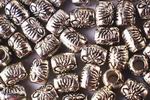


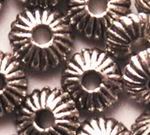
Although findings are essential for creating any kind of jewelry, it's easy to
forget about them when you are shopping for beads. Findings are like background
music in movies. Jewelry with no findings will fail to dazzle, just like a movie
with no music will fail to thrill the audience. The findings enhance and accent
the focal beads without drawing too much attention to themselves, but you really
need to have them to create a functional jewelry.
You need wires to string the beads onto, whether they are flexible beading wire
or rigid wire. You must also have a clasp to create necklaces or bracelets, and
jump rings to attach those clasps. Toggle clasps are the easiest to handle, but
you can also use spring ring or lobster claw clasps if you want an adjustable
length necklace. Spacers are also useful to both add-design and to economize on
the beads used in a project. Items made with flexible wires will need crimp
beads to secure the ends, and you'll want ear wires if you want to make
earrings. These are the must-have items for jewelry making.
You could create beaded jewelry without any metal beads, but they will help your
jewelry appear more professional. They vary greatly in size, thickness, and
shape so you can dramatically alter the style of your necklace by exchanging the
metal beads. Spacers are excellent for adding just a sliver of metallic flash,
while larger beads (often called Bali Beads) may be fancy enough to function as
the focal beads in your designs. Cone or dome-shaped ones called bead caps are
great for topping off a drop.
All of these findings are available in various precious metals, including
Sterling Silver, Sterling Vermeil, Gold-Filled, and Copper. Sterling Vermeil is
made of Sterling Silver with a 24K Gold overlay. Gold-Filled and Copper, on the
other hand, are solid Brass with a Gold or Copper overlay.
to top
About the author – Nigel Mckay
 I'm a 49-year-old Englishman living in both Hong Kong and
Mainland China. One of the first foreigners to enter China's antique and jade
markets over eleven years ago. Now I have an apartment 20-floors above the
entrance to the Canton jade and bead merchants. I spend about 6-days in China,
followed by a similar time in Hong Kong. Traveling three-hours door-to-door by
taxi and train to Hong Kong, where most items are mailed. My wife Mi Mi buys in
China and mails from Hong Kong - and my mother helps with British orders,
posting them from Luton in the UK.
I'm a 49-year-old Englishman living in both Hong Kong and
Mainland China. One of the first foreigners to enter China's antique and jade
markets over eleven years ago. Now I have an apartment 20-floors above the
entrance to the Canton jade and bead merchants. I spend about 6-days in China,
followed by a similar time in Hong Kong. Traveling three-hours door-to-door by
taxi and train to Hong Kong, where most items are mailed. My wife Mi Mi buys in
China and mails from Hong Kong - and my mother helps with British orders,
posting them from Luton in the UK.
I usually work every day for over 80-hours a week. Too long really, but I enjoy it! In July we'll be in the UK - however, a lot of the time we’ll still be working there too. I've been online for over seven years, selling from eBay and nine stores. I have three premium stores powered by Miva software: MrBead.com, onlineoriental.com and awesomerings.com; two Market Works stores, one in US dollars and one in GB pounds; and four eBay stores. I also post around 2,500 listings on eBay, selling under seller 'jensen4', 'betterbead', 'mrbead-uk', 'awesomerings', and ‘gothic-uk’. Most of the work is done on two computers in China, two in Hong Kong, and one in the UK + a laptop.
The hardest part of the whole job is understanding customer’s problems, especially payments that don’t make clear what they are for. This takes a lot of time. Where as large store orders are long to pack, they are easy to process. I used to sell on Yahoo and Amazon + FS and QXL in the UK – but eBay have either closed them down or trampled them to worthless. to top
Chips are a fun and inexpensive way to make jewelry. There is also a very wide range of bead chips available that are ideal for simple bracelets, necklaces or earrings. Bracelets can be quickly made by using elastic string allowing for expansion so they will fit all wrists. Or chips can easily be threaded on thin bangle wire for a more steady effect. These pictures will give you an idea what can be done with these fun-shaped beads.
Chips are sold in much longer strands than other types of beads - usually at least 32-inches long, so if you only want them for bracelets, you don't need so many strands. They will also be the cheapest way of purchasing the stone - so allowing those on a budget to use semi-precious stones they could not otherwise afford. Ships come in all sorts of sizes and shapes. Some like the coral chips on the top right above, are made from very fine hairpins - while others like the carnelian beads on the left of these, are small chunks. Being natural, almost all have irregular size and shape within the strand, and the size quoted is usually the "largest average" on the strand. If you plan on using a strand of chips to make a necklace, you will need to restring them - although they come quite long, this is really only a temporary hold and comes without any hook or clasp. It's a good idea to use a tray or table when working with chips as their tiny size make them easy to loose when take off the strand. Have fun! return to top

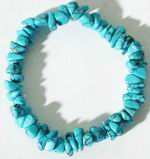






Special 10% Offer !
Sample our beads with 10% discount in our MrBead bead store, just key in "findings" at the checkout (without the
inverted commas) and click "Redeem Coupon".
Offer valid until 7th July only - so act now! Only for use in our store at the checkout and not valid with any other offers.
To see all our carnelian beads click
here
To see all our chip beads click
here
To see all our bead spacers & findings click
here
To see our MrBead store click
http://www.mrbead.com
To return to the top of this page click here